An Exceptional Samurai ‘Kabuto’ Tetsu sabiji 62 ken suji kabuto
An Exceptional Samurai ‘Kabuto’
Tetsu sabiji 62 ken suji kabuto
Lacquer, copper, iron, material, cord, gilding
Signed: Jôshû-jû Saotome Iesada (早乙女家定) ‘Jo-Shu Ju Saotome Iesada’
Japan
Edo Period / Early 17th Century
SIZE: approx: 32cm high - 12½ ins high / 50cm high, 19¾ ins high (with antlers) 35.5cm wide, 37cm deep - 14 ins wide, 14½ ins deep / 77cm high (with base) - 30¼ ins high (with base)
Tetsu sabiji 62 ken suji kabuto
Lacquer, copper, iron, material, cord, gilding
Signed: Jôshû-jû Saotome Iesada (早乙女家定) ‘Jo-Shu Ju Saotome Iesada’
Japan
Edo Period / Early 17th Century
SIZE: approx: 32cm high - 12½ ins high / 50cm high, 19¾ ins high (with antlers) 35.5cm wide, 37cm deep - 14 ins wide, 14½ ins deep / 77cm high (with base) - 30¼ ins high (with base)
An Exceptional Samurai ‘Kabuto’
Tetsu sabiji 62 ken suji kabuto
Lacquer, copper, iron, material, cord, gilding
Signed: Jôshû-jû Saotome Iesada (早乙女家定) ‘Jo-Shu Ju Saotome Iesada’
Japan
Edo Period / Early 17th Century
SIZE: approx: 32cm high - 12½ ins high / 50cm high, 19¾ ins high (with antlers) 35.5cm wide, 37cm deep - 14 ins wide, 14½ ins deep / 77cm high (with base) - 30¼ ins high (with base)
Tetsu sabiji 62 ken suji kabuto
Lacquer, copper, iron, material, cord, gilding
Signed: Jôshû-jû Saotome Iesada (早乙女家定) ‘Jo-Shu Ju Saotome Iesada’
Japan
Edo Period / Early 17th Century
SIZE: approx: 32cm high - 12½ ins high / 50cm high, 19¾ ins high (with antlers) 35.5cm wide, 37cm deep - 14 ins wide, 14½ ins deep / 77cm high (with base) - 30¼ ins high (with base)
‘Helmets of the Saotome School’ Orikasa, T; Taelman, L; and Anseeuw, J; February 1st 2010, pg. 68 and 69, item number 16
‘Koki no Shiori, Suji Kabuto and Koboshi Kabuto from the Late Feudal Period’ Teruo, Orikasa; (translation by Piers Dowding) August 2020, pg. 53
The helmets from the ‘Saotome’ school, are of the finest examples of Japanese helmets. The founder of the ‘Saotome’ school was Saotome Chikara, a middle class ‘vassal’ of Tagaya Shigetsune. He was lord of Hitachi’s Shimotsuma Castle with an annual income of 60,000 Roku. After losing his properties in 1601 due to his refusal to participate in the Battle of Sekigahara, his income reduced dramatically. Remaining in Shimotsuma he started the production of helmets, thus being referred to as the ‘first generation’ of the ‘Saotome’ school, where his descendants still live today.
The ‘bowl’ on our example is of a superior ‘construction’ and quality. Both the ‘Haidate-Dai’ and the ‘Mabisashi’ are ‘Saotome’ style. Two large original ‘Wakidate’ tsunomoto fixed either side on the ‘Koshimaki’. The same ‘Shakudo’ are used to form a fukurin around the edges of the ‘Fukigaeshi’ and the ‘Mabisashi’. The ‘Tehen-no-Za’ is formed of six layered fittings made from gilded copper and Shakudo. The ‘Shikoro’ are ‘Tetsu Kuro Nuri’ lame plates, in the six stage ‘Hineno’ style, Kon (dark indigo) ito ‘Sugake-odoshi, the lower section showing ‘Uname’ and ‘Hishinui’, one layer of Hi-ito (scarlet) and the lower edge covered in a leather fukurin. The ‘Fukigaeshi’ are ‘rounded square’ in appearance, with black lacquered facings, and gilt copper ‘Mongane’ crests of ‘Jiku-tsuki Mittsu Fuji Tomoe’ (three wisteria branches swirling out from a central axis). To the inside of the reverse central plate signed: ‘Jo-Shu Ju Saotome Iesada’.
‘Koki no Shiori, Suji Kabuto and Koboshi Kabuto from the Late Feudal Period’ Teruo, Orikasa; (translation by Piers Dowding) August 2020, pg. 53
The helmets from the ‘Saotome’ school, are of the finest examples of Japanese helmets. The founder of the ‘Saotome’ school was Saotome Chikara, a middle class ‘vassal’ of Tagaya Shigetsune. He was lord of Hitachi’s Shimotsuma Castle with an annual income of 60,000 Roku. After losing his properties in 1601 due to his refusal to participate in the Battle of Sekigahara, his income reduced dramatically. Remaining in Shimotsuma he started the production of helmets, thus being referred to as the ‘first generation’ of the ‘Saotome’ school, where his descendants still live today.
The ‘bowl’ on our example is of a superior ‘construction’ and quality. Both the ‘Haidate-Dai’ and the ‘Mabisashi’ are ‘Saotome’ style. Two large original ‘Wakidate’ tsunomoto fixed either side on the ‘Koshimaki’. The same ‘Shakudo’ are used to form a fukurin around the edges of the ‘Fukigaeshi’ and the ‘Mabisashi’. The ‘Tehen-no-Za’ is formed of six layered fittings made from gilded copper and Shakudo. The ‘Shikoro’ are ‘Tetsu Kuro Nuri’ lame plates, in the six stage ‘Hineno’ style, Kon (dark indigo) ito ‘Sugake-odoshi, the lower section showing ‘Uname’ and ‘Hishinui’, one layer of Hi-ito (scarlet) and the lower edge covered in a leather fukurin. The ‘Fukigaeshi’ are ‘rounded square’ in appearance, with black lacquered facings, and gilt copper ‘Mongane’ crests of ‘Jiku-tsuki Mittsu Fuji Tomoe’ (three wisteria branches swirling out from a central axis). To the inside of the reverse central plate signed: ‘Jo-Shu Ju Saotome Iesada’.
Luc Taelman collection
Ex Private collection
Ex Private collection
An Exceptional Samurai ‘Kabuto’ Tetsu sabiji 62 ken suji kabuto
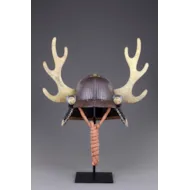
SOLD
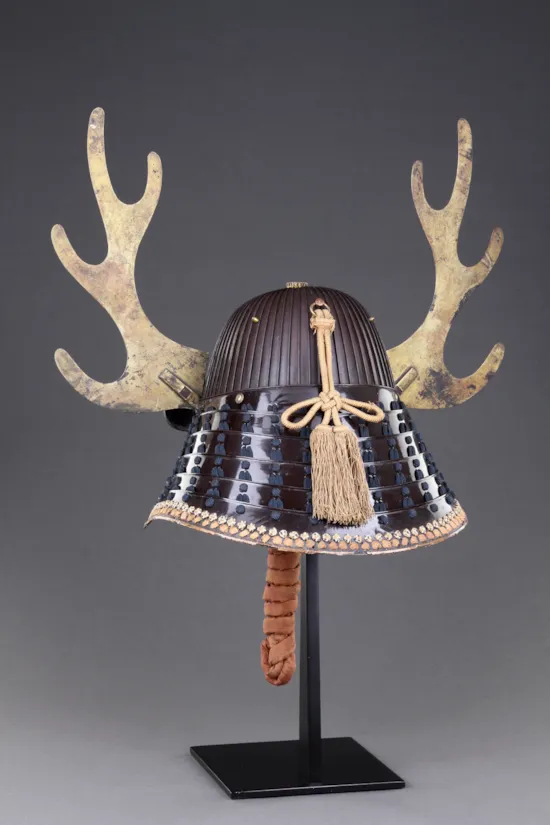
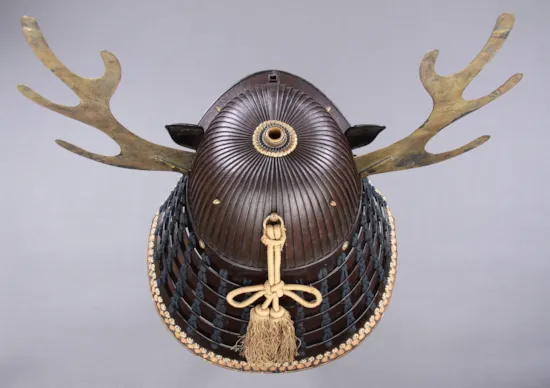
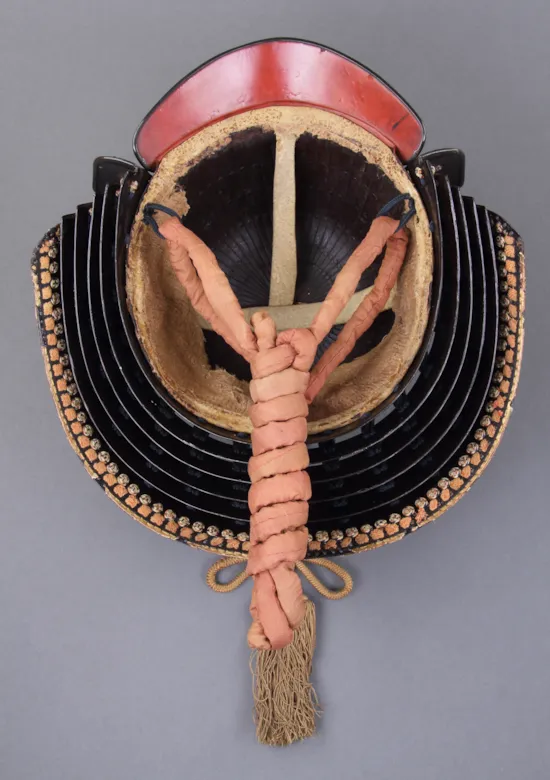
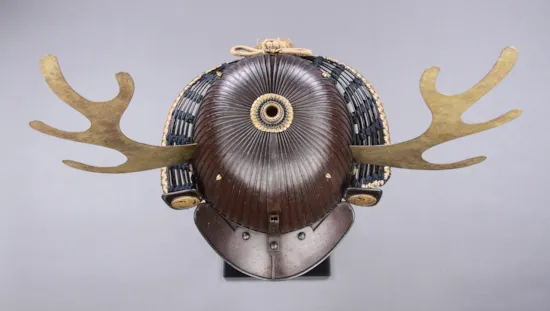




YOU MAY ALSO LIKE

